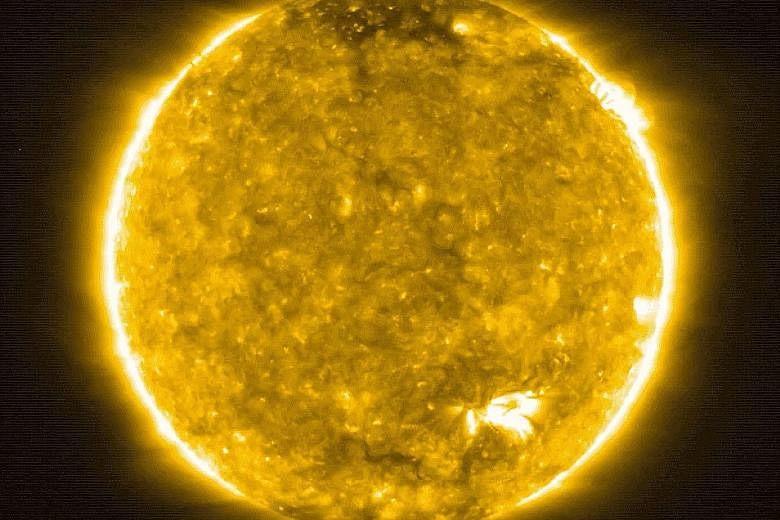NEW YORK • The first images from a new solar mission - the closest ever taken of the Sun - reveal a ubiquitous burbling of miniature solar flares.
The discovery may provide clues for how turbulence heats the atmosphere of the Sun and drives the ebb and flow of solar wind, the high-velocity charged particles throughout the solar system that buffet Earth and the other planets.
"We've never been closer to the Sun with a camera," Dr Daniel Muller, the project scientist for the mission, Solar Orbiter, said at a news conference held on Thursday by the European Space Agency. "And this is just the beginning of the long epic journey of Solar Orbiter."
The miniature solar flares, which the scientists call campfires, were seen as the spacecraft made its first close approach to the Sun. It came within 77 million km of the Sun's surface, which is just a bit more than half the distance between Earth and the Sun.
The campfires are about one-millionth or one-billionth the size of flares that have been observed from Earth. The Sun is in the quiet part of its 11-year solar cycle, and the surface looks placid.
"But then when you look at it at high resolution, it's amazing, in the smallest details, how much stuff is going on there," said Dr David Berghmans of the Royal Observatory of Belgium. He is principal investigator of an instrument that takes high-resolution images of the lower layers of the Sun's atmosphere.
"We couldn't believe this when we first saw this. And we started giving it crazy names like campfires and dark fibrils and ghosts and whatever we saw."
Solar Orbiter is a joint mission between the Europeans and the National Aeronautics and Space Administration, which paid for the rocket that took the probe to space.
One of the spacecraft's other instruments measures the magnetic field near the surface of the Sun.
And it was already able to observe an active region on a part of the surface that is not visible from Earth.
"That's exciting because we know that the magnetic field is a kind of holistic feature of the Sun," said Professor Sami Solanki of the Max Planck Institute for Solar System Research. He is the principal investigator of that instrument.
"It spreads through the atmosphere and connects very different parts of the Sun with each other."
With the new views, "we're starting to see the whole beast", he said.
Launched in February, this mission will provide a new perspective of the Sun as it completes 22 orbits in 10 years.
While most previous solar missions orbited in the ecliptic, or the same plane that the planets travel around the Sun, the orbit of Solar Orbiter will tilt upwards so that it will have a better view of the star's north and south poles.
That change of view could help solve mysteries about the Sun's magnetic fields and how they accelerate those solar wind particles.
The data from Solar Orbiter could help explain the sunspot cycle - Why does the cycle last 11 years? Why are some quiet while others roar violently? - and help models to predict solar storms that could disrupt Earth's power grids and satellites in orbit.
NYTIMES

